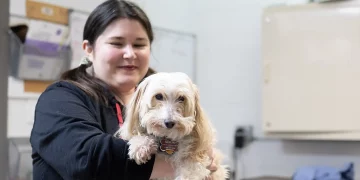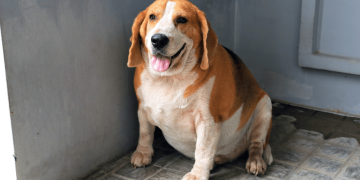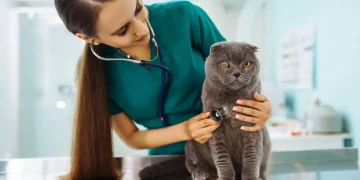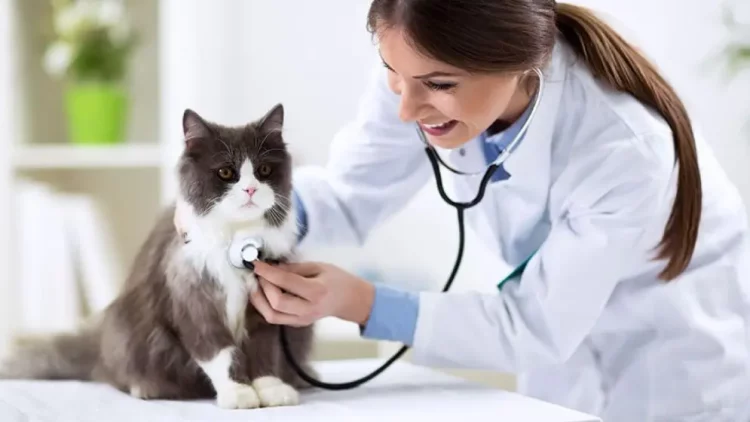As a pet owner, it’s essential to be proactive about your pet’s health and well-being. While pets cannot express their discomfort in the same way humans can, they often show signs that something is wrong. Recognizing these signs early on can help prevent more severe health issues in the future. But how do you know when it’s time to take your pet to the vet? This article will guide you on how to identify when your pet might need professional care.
1. Changes in Eating and Drinking Habits
A sudden change in your pet’s eating or drinking habits can be a clear sign of health issues. Both a decrease or an increase in appetite, as well as excessive drinking or a lack of drinking, can be signs of underlying conditions that may require veterinary attention.
Signs to Look For:
- Loss of Appetite: If your pet suddenly refuses to eat or shows a disinterest in food, this could indicate various health problems, including dental issues, gastrointestinal problems, infections, or even more serious conditions like kidney disease or cancer.
- Increased Appetite: If your pet is eating more than usual, it could be a sign of a hormonal imbalance, diabetes, or even parasites.
- Excessive Thirst: If your pet is drinking much more water than normal, it could indicate diabetes, kidney disease, or urinary tract infections.
- Reduced Water Intake: If your pet is drinking less than usual or refusing water, it could be a sign of dehydration, kidney problems, or other severe illnesses.
2. Changes in Behavior or Activity Levels
A sudden change in behavior or activity levels is often one of the first signs that something may be wrong. Pets are usually creatures of habit, and any significant deviation from their usual behavior warrants attention.
Signs to Look For:
- Lethargy: If your pet is suddenly more tired than usual, refuses to play, or sleeps more than normal, it may indicate pain, illness, or discomfort.
- Increased Restlessness: If your pet is pacing, restlessly wandering, or seems anxious, they could be experiencing discomfort or pain that requires attention.
- Aggression or Unusual Behavior: If your normally calm pet suddenly becomes aggressive or acts out of character, it could be a sign of pain or distress. Cats, in particular, may become irritable when they are in pain or feeling unwell.
3. Vomiting and Diarrhea
Vomiting and diarrhea are common occurrences, but frequent or severe instances should not be ignored. If your pet is vomiting regularly or experiencing diarrhea that lasts more than a day, it’s time to consult a vet. These could be symptoms of infections, parasites, or gastrointestinal issues.
Signs to Look For:
- Frequent Vomiting: If your pet vomits multiple times a day or if the vomit contains blood, bile, or undigested food, it’s important to see a veterinarian.
- Diarrhea: Diarrhea that lasts more than 24-48 hours or that has a particularly foul odor may indicate an infection, food intolerance, or more serious gastrointestinal conditions.
- Vomiting and Diarrhea Together: If both symptoms are present together, especially with other signs of distress such as lethargy or dehydration, your pet may need immediate veterinary attention.
4. Unexplained Weight Loss or Gain
Sudden or unexplained weight loss or gain can be a warning sign of various health conditions. It is important to keep an eye on your pet’s weight and recognize when it may be fluctuating outside of a healthy range.
Signs to Look For:
- Sudden Weight Loss: If your pet is losing weight despite eating normally or even excessively, this could indicate metabolic or gastrointestinal issues, diabetes, or cancer.
- Sudden Weight Gain: On the other hand, unexplained weight gain can be due to issues such as hormonal imbalances, fluid retention, or a lack of exercise.
5. Changes in Urination or Defecation
Changes in your pet’s urination or defecation habits can indicate several health issues, such as urinary tract infections, kidney disease, or gastrointestinal issues.
Signs to Look For:
- Frequent Urination: If your pet is urinating more frequently than usual, it could be a sign of a urinary tract infection, diabetes, or kidney disease.
- Straining to Urinate or Defecate: If your pet seems to be straining or having difficulty urinating or defecating, this could indicate a blockage or infection, especially in male pets.
- Blood in Urine or Stool: Blood in either the urine or stool is always a serious concern and should be examined by a veterinarian immediately.

6. Skin, Coat, and Coat Changes
Your pet’s skin and coat can be a good indicator of their overall health. Regularly inspect your pet’s skin and coat to spot signs of allergies, infections, parasites, or other health issues.
Signs to Look For:
- Excessive Shedding: While some shedding is normal, excessive or unusual shedding could indicate nutritional deficiencies, stress, or underlying health problems.
- Dry or Itchy Skin: Dry, flaky skin or persistent itching may be a sign of allergies, parasites (like fleas or mites), or fungal infections.
- Hair Loss: If your pet is experiencing bald patches or thinning fur, it could be a sign of skin infections, parasites, or hormonal imbalances.
- Redness, Rash, or Sores: These could be signs of allergies, bacterial or fungal infections, or even autoimmune diseases.
7. Respiratory Issues
Breathing difficulties should always be taken seriously. Whether it’s a sudden change in breathing patterns or persistent coughing, respiratory issues can indicate infections, allergies, heart disease, or other health problems.
Signs to Look For:
- Coughing or Wheezing: Coughing, wheezing, or unusual breathing sounds could be signs of respiratory infections, heart problems, or even asthma in cats.
- Labored Breathing: If your pet is struggling to breathe or appears to be panting excessively even when resting, it could indicate a serious issue such as heart disease or pneumonia.
- Sneezing and Nasal Discharge: If your pet is frequently sneezing or has a runny nose, it could be a sign of a respiratory infection or allergies.
8. Oral Health Problems
Oral health is often overlooked, but it plays a significant role in your pet’s overall health. Poor dental health can lead to serious infections, heart disease, and even difficulty eating.
Signs to Look For:
- Bad Breath: If your pet’s breath smells particularly bad, it could be a sign of dental disease or an underlying infection.
- Drooling or Difficulty Eating: Excessive drooling or difficulty eating food could indicate dental problems, oral ulcers, or even a foreign object stuck in your pet’s mouth.
- Bleeding Gums or Teeth: If your pet’s gums are red, inflamed, or bleeding, it’s important to take them to the vet for a dental checkup.
9. Limping or Lameness
If your pet is limping, refusing to walk, or showing signs of pain when moving, it could be an indication of an injury or joint problems. Pets that are older may also experience arthritis, which can cause stiffness and discomfort.
Signs to Look For:
- Limping: Any lameness, limping, or difficulty in movement should be evaluated by a vet to rule out fractures, sprains, or joint issues.
- Excessive Licking or Biting: Pets that are licking or biting a specific part of their body may be trying to relieve pain from an injury or arthritis.
- Reluctance to Exercise: If your pet is avoiding their usual play activities or seems hesitant to walk or run, it may be due to pain or discomfort.
10. Sudden, Unexplained Behavior Changes
Sometimes, pets can exhibit behavior changes that signal something is wrong internally, such as illness or pain.
Signs to Look For:
- Sudden Aggression or Withdrawal: If your pet suddenly becomes unusually aggressive or withdrawn, it could be a sign of pain, neurological issues, or fear due to an illness.
- Unusual Vocalization: Increased vocalization or excessive meowing/barking can indicate distress or discomfort, particularly in older pets.
Conclusion
While pets can be masters at hiding discomfort, paying attention to the signs and symptoms they exhibit can help you catch potential health issues early. Regular check-ups with your veterinarian are essential for maintaining your pet’s well-being, but knowing when your pet is showing signs of illness or distress can help you take prompt action and prevent more serious conditions from developing.
If you’re ever in doubt about whether your pet should see a vet, it’s always better to err on the side of caution and make the appointment. Early intervention can lead to a faster recovery and help ensure your pet leads a long, happy, and healthy life.























































